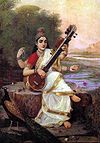- Todi (raga)
-
For Carnatic raga Todi, see Hanumatodi.
Todi (Hindi: तोडी) is a Hindustani classical raga which gave its name to the Todi thaat, one of the ten modes of Hindustani classical music. Ragas from the Todi raganga include Todi (a.k.a. Miya ki Todi) itself, Bilaskhani Todi, Bahaduri Todi, and Gujari Todi.
The equivalent raga in Carnatic music is Shubhapantuvarali. Carnatic music also has a raga named Todi, also known as Hanumatodi, which is the equivalent of Bhairavi and does not have any similarity to the Hindustani Todi.
Contents
Aroha & Avaroha
Arohana
S r g M+ d N S' or
'd 'N S r g M+ d N S' or
S r g M+ d P , M+ d N S' or
S r g M+ P , M+ d N S'Avarohana
S' N D P M+ G R S or
S N d P M+ d M+ g r g r SVadi and Samavadi
komal Dha and komal Ga
in ascent re, ga and dha are intoned slightly low, and tivra ma is very sharp. In descent the intonaltion of all these notes is normal [2]Pakad or Chalan
The distinctive phrase is r/g-\r\S, where r may be subtly oscillated.[3]
Pa is omitted in ascent, but present and often sustained. [4] Kaufmann mentions that some musicians would call Todi with Pa Miyan Ki Todi, but others would see no difference between Todi and Miyan Ki Todi.
Sometimes the ascent is performed without Sa, starting from Ni.Organization and relationships
Miyan Ki Todi is similar to Gujari Todi and many movements are common, but in Gujari Todi Pa is omitted and there is more emphasis on Re and Dha.
Like Miyan Ki Malhar Miyan Ki Todi is said to be composed by Tansen, but this seems unlikely as the Todi scale in Tansen's time was the scale of today's Bhairavi and the name Miyan Ki Todi appears first in the 19th century literature.[5]Samay (Time)
Todi should be performed in the late morning[6]
Rasa
Todi is nearly always shown as a gentle, beautiful woman, holding a veena and standing in a lovely green forest, surrounded by deers. Kaufman cites the Sangita-Darpana "With a fair erect body like the white lotus, and delicate like the gleaming dew drop, Todi holds the vina and provides fun and frolic to the deer deep in the forest. Her body is anointed with saffron and camphor"
References
- ^ Benward and Saker (2003). Music: In Theory and Practice, Vol. I, p.39. Boston: McGraw-Hill. ISBN 978-0-07-294262-0.
- ^ Kaufmann 1968
- ^ Bor 1997
- ^ Bor 1997
- ^ Bor 1997
- ^ Kaufman 1968, pg. 551
External links
Literature
Bor, Joep (1997), The Raga Guide, Charlottesville,Virginia: Nimbus Records
Kaufmann, Walter (1968), The Ragas of North India, Calcutta: Oxford and IBH Publishing Company.Hindustani Classical Music Concepts 
Instruments Genres Semi-Classical Genres Thaats Categories:- Ragas
Wikimedia Foundation. 2010.
